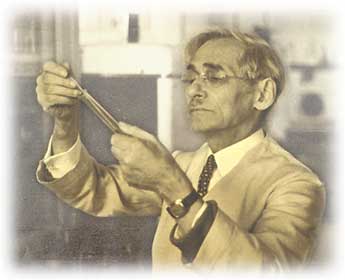Phoebus Levene (c. 1930)

After Miescher's discovery, other scientists found better ways to purify the new substance. Nuclein was a crude extract and contained a lot of proteins. Once the proteins were removed, the "pure" substance became known as deoxyribonucleic acid because of its sugar structure (ribose-based) and its properties (acidic nature). Scientists, such as Phoebus Levene, began deconstructing the DNA components. They found that DNA was essentially a long-chain molecule, made up of four different nucleotides, ribose sugar, and phosphate.
phoebus levene,chain molecule,dna components,deoxyribonucleic acid,nucleotides,phosphate,proteins,scientists,discovery
- ID: 15672
- Source: DNALC.DNAi
Related Content
16342. Animation 15: DNA and proteins are key molecules of the cell nucleus.
Friedrich Miescher and Phoebus Levene research nuclein, protein. and DNA.
1445. DNA
Because it contains the directions for assembling the components of the cell, DNA is often thought of as the "instruction book" for assembling life.
15533. DNA Has Four Units, 3D animation
Blocks to bases, DNA Has Four Units.
16358. Problem 15: DNA and proteins are key molecules of the cell nucleus.
Explore tetranucleotide combinations.
1022. Pathways, Inside the nucleus
In this section learn that an activated protein is transported into the nucleus through a pore in the nuclear membrane.
16515. Animation 23: A gene is a discrete sequence of DNA nucleotides.
Fred Sanger outlines DNA sequencing.
16357. Biography 15: Phoebus Aaron Theodor Levene (1869-1940)
Phoebus Levene was an organic chemist in the early 1900's. He is perhaps best known for his incorrect tetranucleotide hypothesis of DNA.
16471. Animation 21: RNA is an intermediary between DNA and protein.
Francis Crick describes RNA and its role and Paul Zamecnick explains protein synthesis.
16353. Video 15: Thomas Sakmar, clip 2
Phoebus Levene's contributions -- the distinction between DNA and RNA.
16355. Video 15: Thomas Sakmar, clip 4
Did Levene's tetranucleotide theory affect the development of ideas in the field of nucleic acid research?












